Ingrid Klimke preparing the four-year-old Damon’s Divene for the Young Riding Horse class at the Bundeschampionate. If you wanted to see a young horse ridden correctly, this was it.
Words Chris Hector Pix Ros Neave
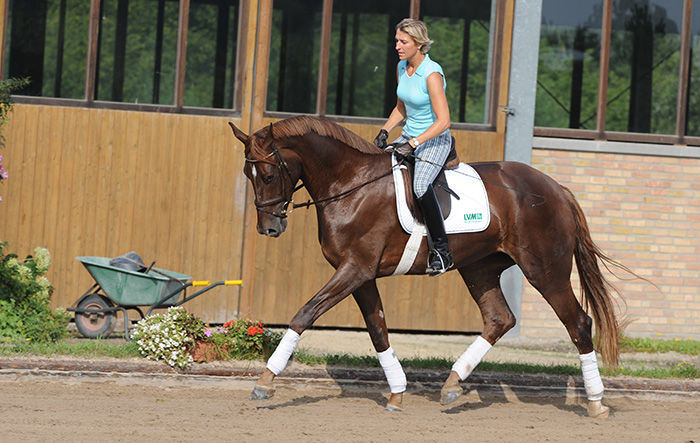
The mare was just so forward, it was the perfect example of how not to become obsessed with what you can see in front of you – ride from the hindquarters into the hand, and maybe at times forget about what you can see: as everyone tells us, ride from behind into the hand.
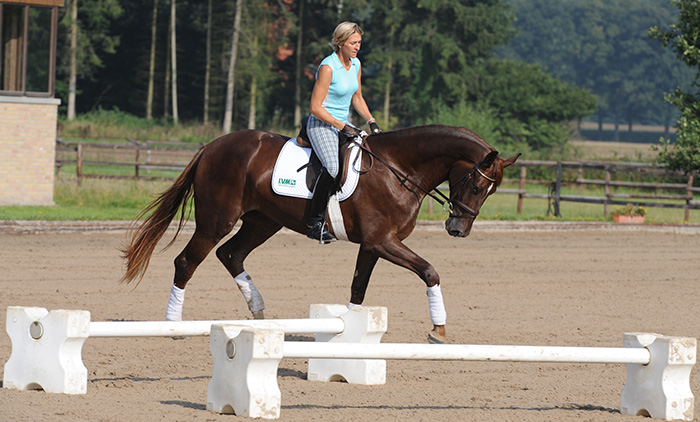
Looking at the training session at home:
“At first it is important that you do rising trot and always try to keep contact – an active, normal working trot and ride her from behind, stretching into your hand and guide her and show her that the way is free to take her neck down and stretch her nose forward.”
“Step by step, you always try to go on long lines, and big circles, come with your leg, give again, she gives, you give, pat her and explain to her – yes, that is the way, now try to stretch more and give your back.”
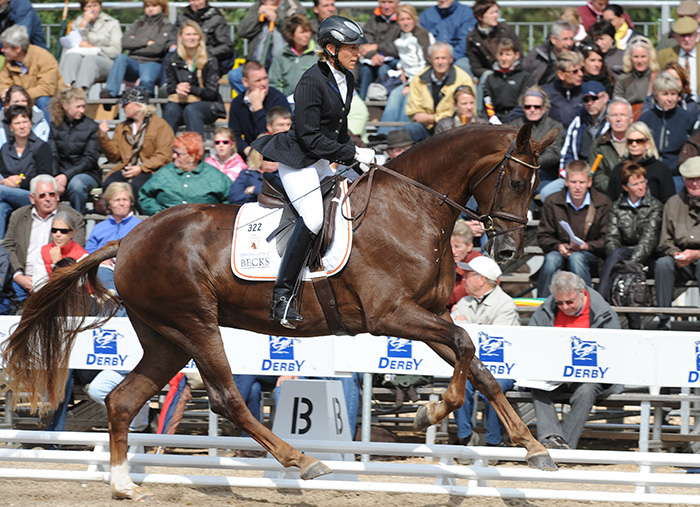
A couple of times in the class at the Championships she became distracted and looked around… but you didn’t correct her strongly, just kept riding…
“She was looking at the people, reacting to the strange noises, because at home, she usually feels very safe in her routine. She is only young, and I haven’t done very much with her, but at home she knows exactly her schedule – but when she heard the loud speakers and all the other horses, she was looking, and I said, come on, trust me. It is just important to keep her forward, from behind into your hand, that’s very important, don’t start just trying to pull her neck down, it is more important that she stays in rhythm, and into your hand. And you hope that with the forwardness she feels, oh ah, I get the rhythm, and she starts to feel secure and starts to stretch again.”
Here when we were watching you work her at home, it’s the beginning of the working session and she is a little deeper…
“From the stretching this is the best, there she is really round with her nose as far as possible, this would be the stretching in the beginning – more when you want her to really stretch much more down.”
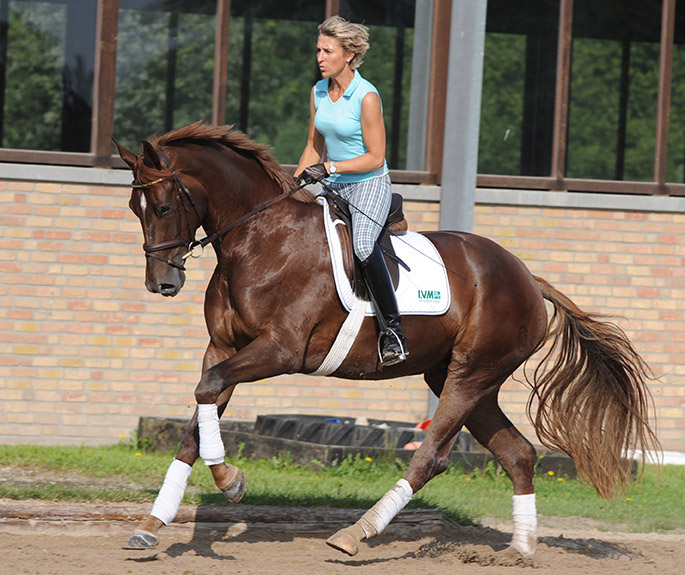
“Later you try to take her up and bit and ride her a little more in self carriage. If you only canter her in the light seat and only ask her to stretch, you must be careful that you don’t do it too long so she falls on the forehand, because she needs to learn to stay in her natural uphill balance. First you try to make her back very round and supple, and when you feel, oh now she is loosened up, then you can sit. Try to sit not too heavy, try to sit in the middle in balance with her, and feel that she has the chance to carry herself and her canter stride is big and not too much on the forehand.
“You see her hind leg very much jumping underneath, and here, she carries herself quite nicely in the turn.”
At this stage are you worried about straightness, or just forward?
“Forward yes, but forward and not running. It is important that there is balance, and you feel the stride is going round and uphill. Not so fast that she is trying to catch up and running out of balance…”
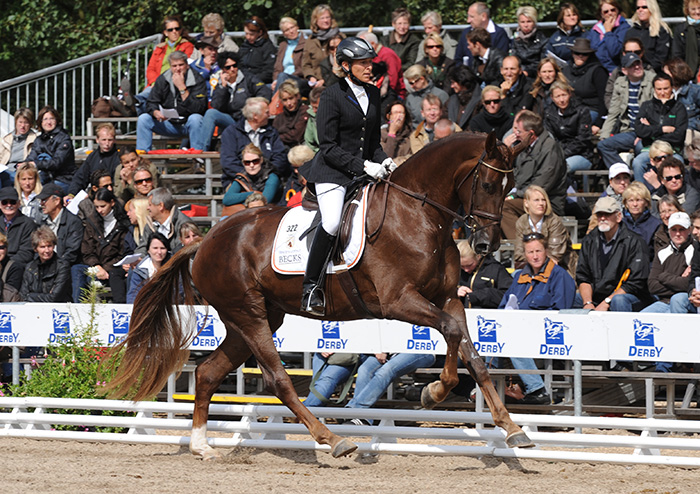
If she gets a little crooked, are you worried?
“Not so much in the beginning because that will come. When they are three and four, they have a hard time sometimes to go on the circle and then when you come to a straight line, they start to go like a snake because they are looking for a secure line to follow. If I feel there is too much crookedness, then I always think of aligning the front to try to keep the shoulder. She comes with the inside leg a bit, I try to bring across the outside shoulder, and ride her in the rhythm and balance.”
The length of the canter stride at the Bundeschampionate was fantastic…
“I really could feel that she was growing, and on the one hand you want to open up and go forward, and on the other you mustn’t rush. She mustn’t feel stride, stride, stride to catch up, no take your time and try to open up, really use the inside hind leg on every turn to make her carry on the long side, but then the next turn is coming…”
With a canter like that do we thank Ingrid Klimke for her good training, or her sire, Damon Hill for his good genes?
“I think both, it comes from Damey definitely, it is in his nature because he has got it as well, and I know from the personality, she is so like him. So much trying to please you and willing, always listening to the rider and thinking ‘what do you want me to do?’ That’s totally Damon Hill’s attitude. She wasn’t spooky in a way that she wanted to turn or go out of the arena, she was really interested. ‘Spooky’ I think is negative, more attentive, sensitive, once she realized there was not a wild lion in the bushes, only some people, then she was right away saying ‘okay I’m fine because I know everything will be safe’. I think young horses look for safety, they must know that you guide them, and give them security, but don’t put too much pressure on them because then they hold themselves and stop breathing. It is important that they breathe.”

With a young horse is it more important to have that natural canter than a trot?
“Yes, the canter and the walk are both gaits you can’t improve by good riding, you can improve them a bit, but you are not going to all-of-a-sudden create a spectacular walk if the walk is not by nature so good, and it is the same with the canter. But the trot, maybe you can’t get a normal trot really expressive, but you can get rhythm and you can always improve it. The more they learn to sit on the hocks, the more strength they get, the more they come into self balance and they build strong hind leg and back muscles, through lots of transitions, half steps in and out, then you can really improve the trot a lot. Look at all the eventers, which Thoroughbred has a wonderful trot? My horse, Braxi (Butts Abraxis) is the best example, he can trot like a little pony but then all of a sudden he opens up and he really knows, ‘ah, I have to lengthen’.”
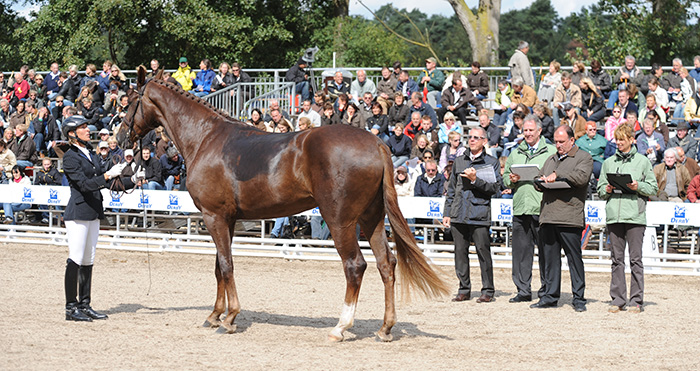
And at the Bundeschampionate, we saw that correct preparation is its own reward – Divene was the Champion of the Three and Four-year-old Mares and Geldings.
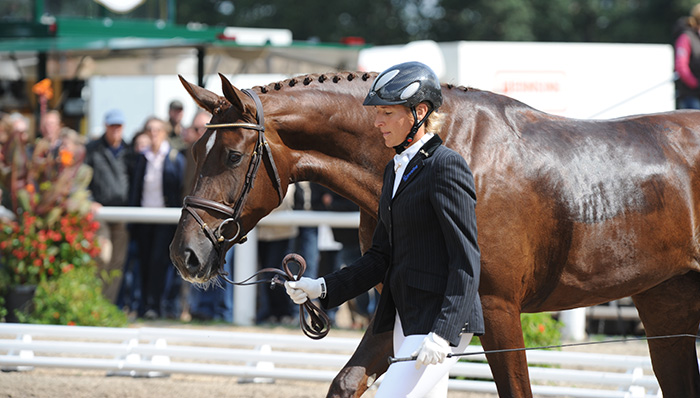
Want to breed to one of the most successful D line stallions of all times? De Niro, plus there’s lots of other top European stallions to choose from, go to www.ihb.com.au
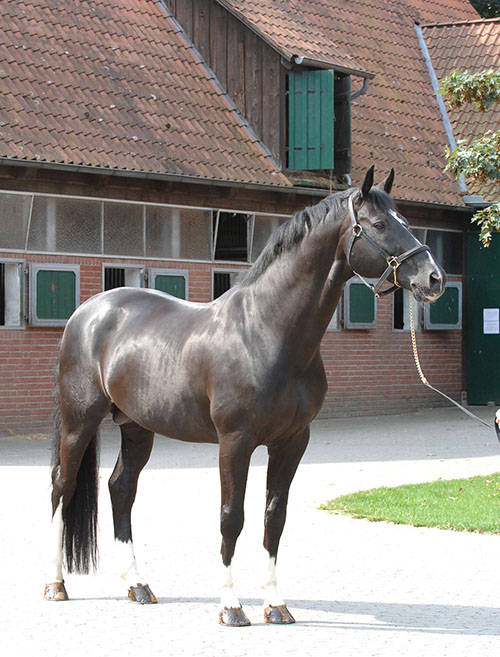

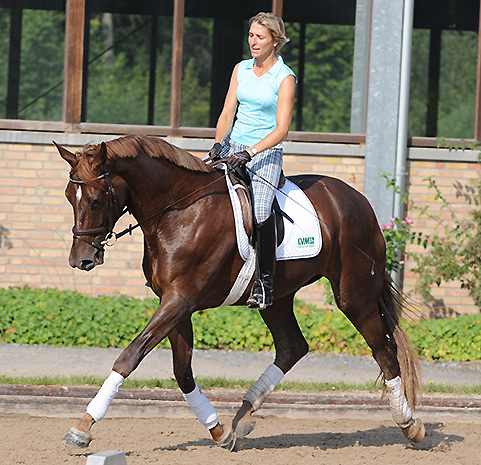
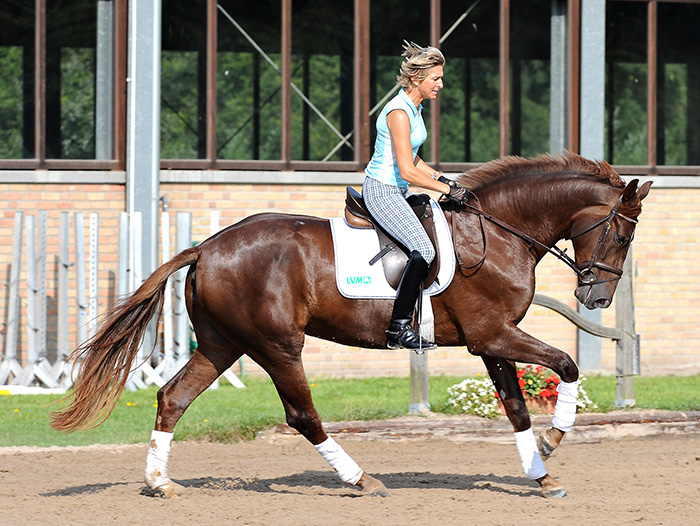
Lovely article and also brilliantly illustrated. I just love the sound advice and solid, simply theory behind while respecting the horse in his own right as an animal of flight. Very much enjoyed reading this!
Kirstin
This article was so refreshing. It’s a credit to you Chris and Roz to share such wealth with Australian riders. Here we so often see coaches teaching interschool riders (for example) to pull the head to the body; yelling ’rounder’ ’rounder’ across the arena! Instead, as you know, we must ride the horse to the bridle. Only then will our horses’ have the chance of reaching their true physical potential. On a related note, every rider in Australia would do well to read ‘Horses Are Made To Be Horses’ by the late Franz Mairinger. He explains these principles perfectly!! Happy riding …
Wonderful reading and advice more trainers should still remember with young horses and young dressage competitions today, you just don’t see much of it not even in the warm up arena. I think more than just a mark should allocated to this, it should be the most important score. Young horses need to build up the strength through self balance and forwardness into the hand working round and through the back, it doesn’t stop just because they’re in the ring either. This seems to have all but been forgotten in the quest to show a good trot and uphill front. Legs going, often paddling in the air with no body follow through at all, hollow backs in the canter and hinds far out the back. A horse has to take and trust your hand completely to be able to follow its subtle instruction, to know to lengthen down and round. Instead we are still getting mini (timid) versions of the rollkeur in warm ups. Even young two year old horses on the lunge for auction, strapped up to show a flashy trot, stiff backed and cow hocked for balance on tight circles.
I think we have learnt that we needed to go back to go forward in horse training but some are still in hurry. The first book I ever read about dressage was by Ingrid’s dad Reiner Klimke and I’ve never forgotten a word of it, then I found one of his earliest training videos. When I was in Europe in the nineties particularly in Belgium and the Netherlands I was horrified that all those ideas seemed to have vanished. Well established up until the eighties but all but gone in the decade following as breeding produced more and more horses with uphill front ends, trainers thought they were ready but all you got where hollow backs, behind the vertical heads and trailing hinds. I would say right up until the fiasco with Van Grunsven and Janssen’s training methods to Totilas. They never revolutionised training methods just broke them. Even now you are seeing riders in grand Prix who retire during important international events because they’ve lost control of their horses and have no way to bring them back, yes even in the German teams. The banning of rollkeur changed the order of dressage almost completely over night but riders are still and remarkably so battling with what to replace it with. They need to go back a bit read Reiner’s words, remember the basics of training and the training scale and respect for the horse at every step, be it on the ground training or in the saddle.
Does any one know what type of saddle Ingrid uses? I notice that she has a regular girth ( which my horse prefers). The photos in her training book a
So show a long girth. Thanks